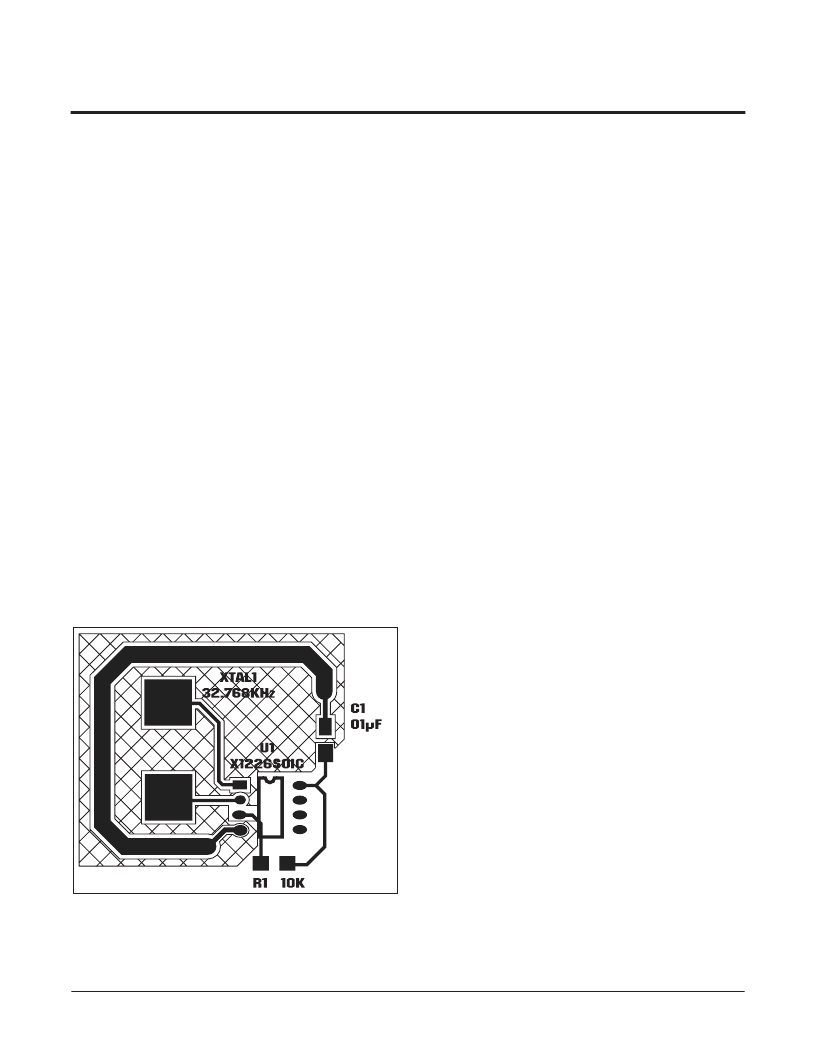- 您現(xiàn)在的位置:買賣IC網(wǎng) > PDF目錄372527 > X1226 (Intersil Corporation) Real Time Clock/Calendar with EEPROM PDF資料下載
參數(shù)資料
| 型號(hào): | X1226 |
| 廠商: | Intersil Corporation |
| 英文描述: | Real Time Clock/Calendar with EEPROM |
| 中文描述: | 實(shí)時(shí)時(shí)鐘/日歷帶有EEPROM |
| 文件頁(yè)數(shù): | 19/24頁(yè) |
| 文件大?。?/td> | 420K |
| 代理商: | X1226 |
第1頁(yè)第2頁(yè)第3頁(yè)第4頁(yè)第5頁(yè)第6頁(yè)第7頁(yè)第8頁(yè)第9頁(yè)第10頁(yè)第11頁(yè)第12頁(yè)第13頁(yè)第14頁(yè)第15頁(yè)第16頁(yè)第17頁(yè)第18頁(yè)當(dāng)前第19頁(yè)第20頁(yè)第21頁(yè)第22頁(yè)第23頁(yè)第24頁(yè)

X1226
REV 1.1.24 1/13/03
Characteristics subject to change without notice.
19 of 24
www.xicor.com
A final application for the ATR control is in-circuit cali-
bration for high accuracy applications, along with a
temperature sensor chip. Once the RTC circuit is pow-
ered up with battery backup, the PHZ output is set at
32.768kHz and frequency drift is measured. The ATR
control is then adjusted to a setting which minimizes
drift. Once adjusted at a particular temperature, it is
possible to adjust at other discrete temperatures for
minimal overall drift, and store the resulting settings in
the EEPROM. Extremely low overall temperature drift
is possible with this method. The Xicor evaluation
board contains the circuitry necessary to implement
this control.
For more detailed operation see Xicor’s application
note AN154 on Xicor’s website at www.xicor.com.
Layout Considerations
The crystal input at X1 has a very high impedance and
will pick up high frequency signals from other circuits
on the board. Since the X2 pin is tied to the other side
of the crystal, it is also a sensitive node. These signals
can couple into the oscillator circuit and produce dou-
ble clocking or mis-clocking, seriously affecting the
accuracy of the RTC. Care needs to be taken in layout
of the RTC circuit to avoid noise pickup. Below in Fig-
ure 15 is a suggested layout for the X1226 or X1227
devices.
Figure 15. Suggested Layout for Xicor RTC in SO-8
The X1 and X2 connections to the crystal are to be
kept as short as possible. A thick ground trace around
the crystal is advised to minimize noise intrusion, but
ground near the X1 and X2 pins should be avoided as
it will add to the load capacitance at those pins. Keep in
mind these guidelines for other PCB layers in the vicin-
ity of the RTC device. A small decoupling capacitor at
the Vcc pin of the chip is mandatory, with a solid con-
nection to ground.
The X1226 product has a special consideration. The
PHZ/IRQ- pin on the 8-lead SOIC package is located
next to the X2 pin. When this pin is used as a fre-
quency output (PHZ) and is set to 32.768kHz output
frequency, noise can couple to the X1 or X2 pins and
cause double-clocking. The layout in figure 15 can help
minimize this by running the PHZ output away from the
X1 and X2 pins. Also, minimizing the switching current
at this pin by careful selection of the pullup resistor
value will reduce noise. Xicor suggests a minimum
value of 5.1k
for 32.768kHz, and higher values (up to
20k
) for lower frequency PHZ outputs.
For other RTC products, the same rules stated above
should be observed, but adjusted slightly since the
packages and pinouts are slightly different.
Assembly
Most electronic circuits do not have to deal with
assembly issues, but with the RTC devices assembly
includes insertion or soldering of a live battery into an
unpowered circuit. If a socket is soldered to the board,
and a battery is inserted in final assembly, then there
are no issues with operation of the RTC. If the battery
is soldered to the board directly, then the RTC device
Vback pin will see some transient upset from either sol-
dering tools or intermittent battery connections which
can stop the circuit from oscillating. Once the battery is
soldered to the board, the only way to assure the circuit
will start up is to momentarily (very short period of
time!) short the Vback pin to ground and the circuit will
begin to oscillate.
Oscillator Measurements
When a proper crystal is selected and the layout guide-
lines above are observed, the oscillator should start up
in most circuits in less than one second. Some circuits
may take slightly longer, but startup should definitely
occur in less than 5 seconds. When testing RTC cir-
cuits, the most common impulse is to apply a scope
probe to the circuit at the X2 pin (oscillator output) and
observe the waveform. DO NOT DO THIS! Although in
some cases you may see a useable waveform, due to
the parasitics (usually 10pF to ground) applied with the
相關(guān)PDF資料 |
PDF描述 |
|---|---|
| X1226S8 | Real Time Clock/Calendar with EEPROM |
| X1226S8I | POT 500 OHM 6MM CERMET VERT |
| X1226S8IT1 | POT 500 OHM 6MM CERMET VERT |
| X1226S8IZ | POT 5.0K OHM 6MM CERMET VERT |
| X1226V8IT1 | Real Time Clock/Calendar with EEPROM |
相關(guān)代理商/技術(shù)參數(shù) |
參數(shù)描述 |
|---|---|
| X1226_06 | 制造商:INTERSIL 制造商全稱:Intersil Corporation 功能描述:Real Time Clock/Calendar with EEPROM |
| X122621-AT | 功能描述:基本/快動(dòng)開關(guān) SEALED OI-SE SWITCH RoHS:否 制造商:Omron Electronics 觸點(diǎn)形式:SPDT 執(zhí)行器:Lever 電流額定值:5 A 電壓額定值 AC:250 V 電壓額定值 DC:30 V 功率額定值: 工作力:120 g IP 等級(jí):IP 67 NEMA 額定值: 端接類型:Wire 安裝:Panel |
| X122623-AT | 功能描述:基本/快動(dòng)開關(guān) SEALED OI-SE SWITCH RoHS:否 制造商:Omron Electronics 觸點(diǎn)形式:SPDT 執(zhí)行器:Lever 電流額定值:5 A 電壓額定值 AC:250 V 電壓額定值 DC:30 V 功率額定值: 工作力:120 g IP 等級(jí):IP 67 NEMA 額定值: 端接類型:Wire 安裝:Panel |
| X122624-AT | 功能描述:基本/快動(dòng)開關(guān) SEALED OI-SE SWITCH RoHS:否 制造商:Omron Electronics 觸點(diǎn)形式:SPDT 執(zhí)行器:Lever 電流額定值:5 A 電壓額定值 AC:250 V 電壓額定值 DC:30 V 功率額定值: 工作力:120 g IP 等級(jí):IP 67 NEMA 額定值: 端接類型:Wire 安裝:Panel |
| X122625-AT | 功能描述:基本/快動(dòng)開關(guān) SEALED OI-SE SWITCH RoHS:否 制造商:Omron Electronics 觸點(diǎn)形式:SPDT 執(zhí)行器:Lever 電流額定值:5 A 電壓額定值 AC:250 V 電壓額定值 DC:30 V 功率額定值: 工作力:120 g IP 等級(jí):IP 67 NEMA 額定值: 端接類型:Wire 安裝:Panel |
發(fā)布緊急采購(gòu),3分鐘左右您將得到回復(fù)。